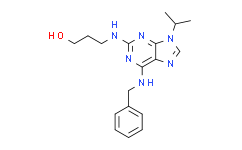| Cas No.: | 189232-42-6 |
| Chemical Name: | 1-Propanol,3-[[9-(1-methylethyl)-6-[(phenylmethyl)amino]-9H-purin-2-yl]amino]- |
| Synonyms: | 1-Propanol,3-[[9-(1-methylethyl)-6-[(phenylmethyl)amino]-9H-purin-2-yl]amino]-;3-[[6-(benzylamino)-9-propan-2-ylpurin-2-yl]amino]propan-1-ol;BOHEMINE;2-(3-hydroxypropylamino)-6-benzylamino-9-isopropylpurine;2-[(3-hydroxypropyl)amino]-6-benzylamino-9-isopropylpurine;AC1L1DN2;CHEMBL83980;CTK8A4395;DNC003611;HMS3229C10;HSCI1_000064;purine deriv. 1;SureCN1443403;Bohemin;3-{[6-(Benzylamino)-9-Isopropyl-9H-Purin-2-Yl]Amino}-1-Propanol;3-((6-(benzylaMino)-9-isopropyl-9H-purin-2-yl)aMino)propan-1-ol |
| SMILES: | CC(C)N1C=NC2=C(NCC3=CC=CC=C3)NC(=NCCCO)N=C21 |
| Formula: | C18H24N6O |
| M.Wt: | 340.42276 |
| Sotrage: | 2 years -20°C Powder, 2 weeks 4°C in DMSO, 6 months -80°C in DMSO |
| Description: | Bohemine is a purine analogue and is a synthetic and selective CDK inhibitor with IC50s of 4.6 μM, 83 μM, and 2.7 μM for Cdk2/cyclin E, Cdk2/cyclin A, and Cdk9/cyclin T1, respectively. Bohemine also inhibits ERK2 with an IC50 of 52 μM and has less inhibitory effect on CDK1, CDK4 and CDK6. Bohemine has a broad spectrum anti-cancer activities[1][2]. |
| In Vivo: | Bohemine (50 mg/kg; intravenous injection; BALB/c mice) treatment shows Cmax is 72,308 nM, observed clearance is 0.23 L/h and T1/2 is 1.39 h[2]. Animal Model: BALB/c mice bearing the colon 26 murine tumor[2] Dosage: 50 mg/kg Administration: Intravenous injection (Pharmacokinetic Analysis) Result: Cmax is 72,308 nM, observed clearance is 0.23 L/h and T1/2 is 1.39 h. |
| In Vitro: | Bohemine (0-30 µM; 72 hours; ME-750 cells) treatment inhibits cell growth. Addition of Bohemine at concentrations in the range of 1-10 µM results in a short-term arrest of growth and of monoclonal antibody production. The short-term suppression of cell functions is followed by a significant temporary increase of specific growth rate and of specific production rate[1]. Hybridoma cells are retarded both at the G1/S boundary and at the G2/M boundary, depending on Bohemine (0-30 µM) concentration[1]. T-lymphoblastic cell line CEM is treated by Bohemine, five proteins are found to be downregulated, namely α-enolase, triosephosphate isomerase, initiation factor 5A, and α- and β-subunits of Rho GDP-dissociation inhibitor 1. These proteins play significant roles in glycolysis, proteosynthesis, and in cytoskeleton rearrangement[1]. Bohemine inhibits growth of human tumor cell lines with an IC50 of 27 µM[2]. Cell Viability Assay[1] Cell Line: Mouse hybridoma ME-750 cells Concentration: 0 µM, 1 µM, 3 µM, 10 µM and 30 µM Incubation Time: 72 hours Result: At 10 µM and 30 µM concentrations, the viable cell count was significantly lower with respect to control, i.e., 77% and 48%, respectively. |

 To enhance service speed and avoid tariff delays, we've opened a US warehouse. All US orders ship directly from our US facility.
To enhance service speed and avoid tariff delays, we've opened a US warehouse. All US orders ship directly from our US facility.




















